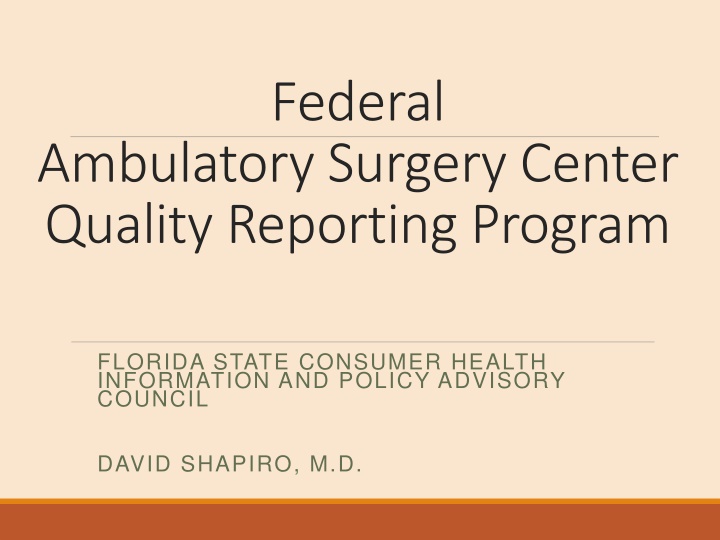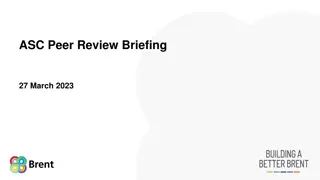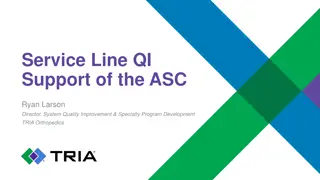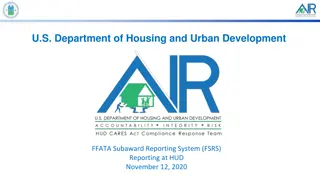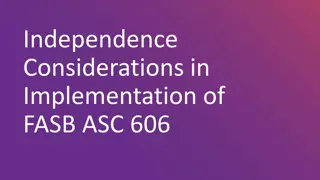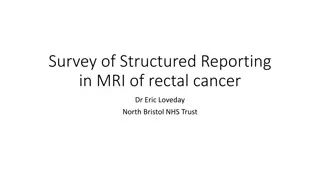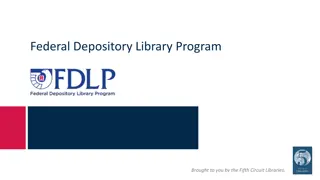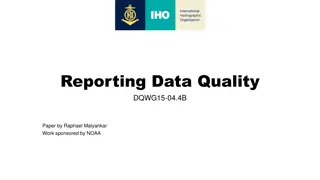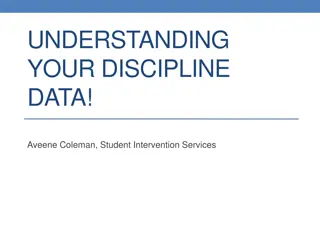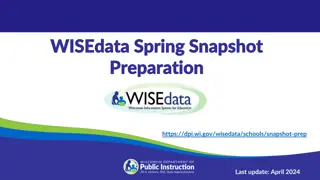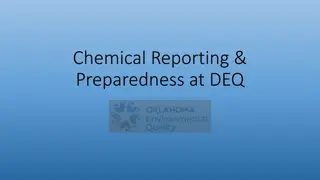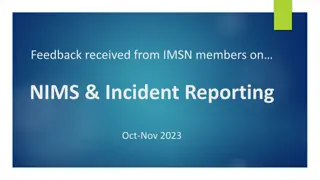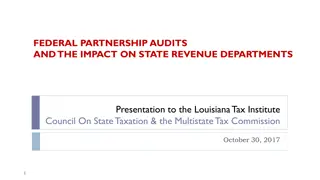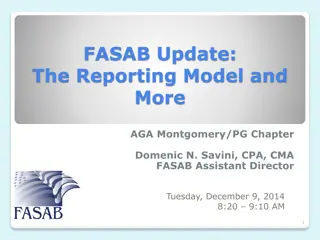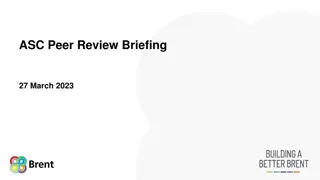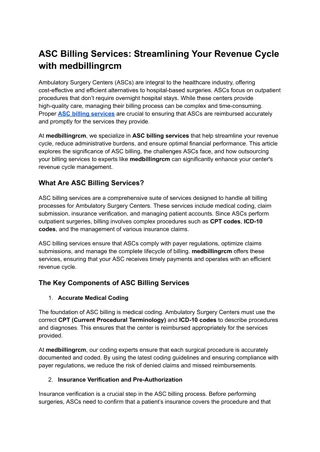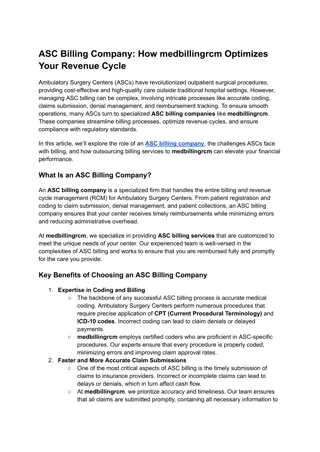Federal Quality Reporting and ASC Collaboration Efforts
Federal Quality Reporting initiatives were launched to ensure quality healthcare for all Americans. The ASC Quality Collaboration has worked to develop standardized quality measures for Ambulatory Surgical Centers. The ASC Quality Reporting Program officially began in October 2012, aiming to improve quality in healthcare services provided by ASCs.
Download Presentation

Please find below an Image/Link to download the presentation.
The content on the website is provided AS IS for your information and personal use only. It may not be sold, licensed, or shared on other websites without obtaining consent from the author.If you encounter any issues during the download, it is possible that the publisher has removed the file from their server.
You are allowed to download the files provided on this website for personal or commercial use, subject to the condition that they are used lawfully. All files are the property of their respective owners.
The content on the website is provided AS IS for your information and personal use only. It may not be sold, licensed, or shared on other websites without obtaining consent from the author.
E N D
Presentation Transcript
Federal Ambulatory Surgery Center Quality Reporting Program FLORIDA STATE CONSUMER HEALTH INFORMATION AND POLICY ADVISORY COUNCIL DAVID SHAPIRO, M.D.
Federal Quality Reporting In November 2001, Health & Human Services (HHS) Secretary Tommy G. Thompson announced The Quality Initiative, his commitment to assure quality healthcare for all Americans through published consumer information coupled with healthcare quality improvement support through Medicare s Quality Improvement Organizations (QIOs). The Quality Initiative was launched nationally in 2002 as the Nursing Home Quality Initiative (NHQI) and expanded in 2003 with the Home Health Quality Initiative (HHQI) and the Hospital Quality Initiative (HQI). These initiatives are part of a comprehensive look at quality of care that includes hospitals, nursing homes, home health agencies, and physician offices.
Federal Quality Reporting In 2006, the ASC community began encouraging the Centers for Medicare & Medicaid Services (CMS) to establish a uniform quality reporting system that would allow ASCs to publicly demonstrate their performance on quality measures. CMS implemented the Ambulatory Surgical Center Quality Reporting (ASCQR) Program on October 1, 2012.
Quality Measure Reporting Federal Measurement Development Process: CMS selects measures that reflect consensus among affected parties and, to the extent feasible and practicable, that these measures include measures set forth by one or more national consensus building entities (e.g. NQF). The ASC community formed the ASC Quality Collaboration in 2006 to initiate the process of developing standardized ASC quality measures
ASC Quality Collaboration Efforts on the Regulatory and Legislative fronts Measure Development process occurs over several years The measures included in the program have been developed using a multi-step process. Each has been vetted with both our internal panel of technical experts and an external panel of individuals and/or organizations with relevant expertise. All of the measures have been pilot tested in ASCs and assessed for validity, feasibility and reliability.
ASC Quality Reporting Program Often referred to as the ASC QRP The ASC quality reporting program officially began on October 1, 2012 Data collection began in CY 2012 for certain measures Applied to the CY 2014 payment determination
ASC QRP Overall Structure ASCs that don t submit quality measure data incur up to a 2.0% reduction to any annual increase provided under the payment system for the specified year Several mechanisms of reporting Staggered implementation of required measures Annual Review New Measures, Retired Measures Many unresolved issues remain
How Data Is Reported Claims Based Reporting-Quality Data Codes Web Based Reporting via QualityNet Secure Portal www.qualitynet.org Web Based Reporting Via Centers for Disease Control and Prevention (CDC) National Health Care Safety Network (NHSN) www.cdc.gov/nhsn/index.html Administrative Claims
Measurement 101 Measures can be divided into two general categories: Outcome and Process The measures developed by the ASC QC include both outcome measures and process measures An outcome measure assesses patients for a specific result of health care intervention. A process measure evaluates a particular aspect of the care that is delivered to the patient.
Measurement 102 Measure Type States whether the measure is an outcome measure or a process measure Description A brief description of what is measured Numerator: Patient population experiencing the outcome or process of care being measured. Denominator: The patient population evaluated. Inclusions/Exclusions of both Numerator and Denominator Data Sources The documents that typically contain the information needed to determine the numerator and denominator Definitions Specific definitions for the terms included in the numerator and denominator statements
Patient Burn This measure is used to assess the number of admissions (patients) that experience a burn prior to discharge Numerator: Ambulatory Surgery Center ASC admissions experiencing a burn prior to discharge Denominator: All ASC admissions. Definition: Burn: Unintended tissue injury caused by any of the six recognized mechanisms: scalds, contact, fire, chemical, electrical or radiation, (e.g. warming devices, prep solutions, electrosurgical unit or laser).
Patient Fall This measure is used to assess the number of admissions (patients) that experience a fall within the ASC Numerator: Ambulatory Surgery Center (ASC) admissions experiencing a fall within the confines of the ASC Denominator: All ASC admissions Definition: Fall: a sudden, uncontrolled, unintentional, downward displacement of the body to the ground or other object, excluding falls resulting from violent blows or other purposeful actions. (National Center for Patient Safety)
Wrong Site, Wrong Side, Wrong Patient, Wrong Procedure, Wrong Implant Description: This measure is used to assess the number of ASC admissions (patients) experiencing a wrong site, side, patient, procedure or implant Numerator: All Ambulatory Surgery Center (ASC) admissions experiencing a wrong site, wrong side, wrong patient, wrong procedure or wrong implant. Denominator Inclusions: All ASC admissions Definitions: Admission: completion of registration upon entry into the facility. Wrong: not in accordance with intended site, side, patient, procedure or implant
All Cause Hospital Transfer/Admission Numerator: Ambulatory Surgery Center (ASC) admissions requiring a hospital transfer or hospital admission upon discharge from the ASC. Denominator: All ASC admissions. Definitions: Admission: completion of registration upon entry into the facility. Hospital transfer/admission: any transfer/admission from an ASC directly to an acute care hospital including hospital emergency room. Discharge: occurs when the patient leaves the confines of the ASC While hospital transfers and admissions undoubtedly represent good patient care when necessary, high rates may be an indicator that practice patterns or patient selection guidelines are in need of review.
Influenza Vaccination Coverage Among Healthcare Personnel Numerator: The numerator for this measure consists of HCP in the denominator population, who during the time from when the vaccine became available (for example, August or September) through March 31 of the following year: received an influenza vaccination administered at the healthcare facility; or reported in writing (paper or electronic) or provided documentation that influenza vaccination was received elsewhere; or were determined to have a medical contraindication/condition of severe allergic reaction to eggs or other component(s) of the vaccine, or history of Guillain- Barr Syndrome (GBS) within 6 weeks after a previous influenza vaccination; or were offered but declined influenza vaccination; or had an unknown vaccination status or did not otherwise meet any of the definitions of the above-mentioned The numerator data are mutually exclusive. The sum of the numerator categories should be equal to the denominator for each HCP group.
Influenza Vaccination Coverage Among Healthcare Personnel Denominator: The denominator for this measure consists of HCP who are physically present in the healthcare facility for at least 1 working day between October 1 and March 31 (for example, the measure reporting period) of the following year. Denominators are to be calculated separately for three required categories of HCP and can also be calculated for a fourth optional category: Employees: This includes all persons who receive a direct paycheck from the reporting facility (for example, on the facility s payroll), regardless of clinical responsibility or patient contact. Licensed independent practitioners (LIPs): This includes physicians (MD, DO), advanced practice nurses, and physician assistants who are affiliated with the reporting facility, but are not directly employed by it (for example, they do not receive a paycheck from the facility), regardless of clinical responsibility or patient contact. Post-residency fellows are also included in this category if they are not on the facility s payroll. Adult students/trainees and volunteers: This includes medical, nursing, or other health professional students, interns, medical residents, or volunteers aged 18 or older who are affiliated with the healthcare facility, but are not directly employed by it (for example, they do not receive a paycheck from the facility), regardless of clinical responsibility or patient contact. Other contract personnel (optional): Facilities may also report on individuals who are contract personnel. However, reporting for this category is optional at this time. Contract personnel are defined as persons providing care, treatment, or services at the facility through a contract who do not fall into any of the above-mentioned denominator categories.
Endoscopy/Polyp Surveillance: Appropriate Follow-up Interval for Normal Colonoscopy in Average Risk Patients Description: Percentage of patients aged 50 to 75 years of age receiving a screening colonoscopy without biopsy or polypectomy who had a recommended follow-up interval of at least 10 years for repeat colonoscopy documented in their colonoscopy report Numerator Statement: Patients who had a recommended follow-up interval of at least 10 years for repeat colonoscopy documented in their colonoscopy report Denominator Statement: All patients aged 50 to 75 years of age receiving screening colonoscopy without biopsy or polypectomy
Endoscopy/Polyp Surveillance: Colonoscopy Interval for Patients with a History of Adenomatous Polyps Avoidance of Inappropriate Use Description: Percentage of patients aged 18 years and older receiving a surveillance colonoscopy, with a history of a prior colonic polyp(s) in previous colonoscopy findings, who had a follow-up interval of 3 or more years since their last colonoscopy Numerator Statement: Patients who had an interval of 3 or more years since their last colonoscopy Denominator Statement: All patients aged 18 years and older receiving a surveillance colonoscopy with a history of a prior colonic polyp(s) in previous colonoscopy findings
Improvement in Patients Visual Function within 90 Days Following Cataract Surgery Description: Percentage of patients aged 18 years and older who had cataract surgery and had improvement in visual function achieved within 90 days following the cataract surgery Numerator Statement: Patients who had improvement in visual function achieved within 90 days following cataract surgery, based on completing both a pre- operative and post-operative visual function instrument Denominator Statement: All patients aged 18 years and older who had cataract surgery and completed both a pre-operative and post-operative visual function instrument Voluntary
Normothermia Description: This measure is used to assess the percentage of patients having surgical procedures under general or neuraxial anesthesia of 60 minutes or more in duration are normothermic within 15 minutes of arrival in PACU. Numerator: Surgery patients with a body temperature equal to or greater than 96.8 Fahrenheit/36 Celsius recorded within fifteen minutes of Arrival in PACU Denominator: All patients, regardless of age, undergoing surgical procedures under general or neuraxial anesthesia of greater than or equal to 60 minutes duration
Unplanned Anterior Vitrectomy Description: This measure is used to assess the percentage of cataract surgery patients who have an unplanned anterior vitrectomy. Numerator: All cataract surgery patients who had an unplanned anterior vitrectomy Denominator: All cataract surgery patients
Facility 7-Day Risk-Standardized Hospital Visit Rate after Outpatient Colonoscopy Description: The measure estimates a facility-level rate of risk-standardized, all-cause, unplanned hospital visits within 7 days of an outpatient colonoscopy among Medicare Fee-for-Service (FFS) patients aged 65 years and older. Rationale: This measure will reduce adverse patient outcomes associated with preparation for colonoscopy, the procedure itself, and follow-up care by capturing and making more visible to providers and patients all unplanned hospital visits following the procedure. The measure score will assess quality and inform quality improvment
Facility 7-Day Risk-Standardized Hospital Visit Rate after Outpatient Colonoscopy Numerator Statement: This outcome measure does not have a traditional numerator and denominator like a core process measure (e.g., percentage of adult patients with diabetes aged 18-75 years receiving one or more hemoglobin A1c tests per year); thus, we are using this field to define the outcome. The calculation of the rate is defined below under Measure Calculation. The outcome for this measure is all-cause, unplanned hospital visits within 7 days of an outpatient colonoscopy. The measure defines a hospital visit as any emergency department (ED) visit, observation stay, or unplanned inpatient admission. Denominator Statement: The target population for this measure includes low-risk colonoscopies performed in the outpatient setting for Medicare FFS patients aged 65 years and older. For implementation in the ASCQR Program, the measure will be calculated among ambulatory surgical centers (ASCs).
Recent Developments Participation Almost all 96.9 percent of Medicare-certified ASCs met the requirements and will receive full payment for the 2018 calendar year. The following measures reported data all reflected better results in 2016 than the previous year: Patient burn Patient fall Wrong site, side, patient procedure, implant Hospital all cause transfer/admission Prophylactic intravenous antibiotic timing Safe surgery checklist use
Recent Developments Measures removed from ASC QRP in 2018: Safe Surgery Checklist Use Prophylactic Intravenous Antibiotic Aiming ASC Facility Volume Data on Selected ASC Surgical Procedures
Future Measures Scheduled for the ASC QRP Hospital Visit after Orthopedic Ambulatory Procedures Hospital Visit After Urology Ambulatory Surgery Procedures The measures are all-cause, unplanned hospital visits (Emergency Department, Observation Stays, Unplanned Inpatient Admission) within 7 days of a procedure in of either categorization No data submission or reporting from the ASC is required Data will be pulled by CMS from the Medicare Fee For Service Administrative Claims during the CY 2020 (January 1, 2020-December 31, 2020)
Possible Future Measures Presently Under Development Surgical Site Infection After Breast Procedure In An Ambulatory Surgery Center (ASC) Unplanned Hospital Visits Within 7 Days After Selected General Surgery Procedures In An Ambulatory Surgical Center (ASC)
OAS CAHPS Five measures are based on the use of the Outpatient and Ambulatory Surgery Consumer Assessment of Healthcare Providers and Systems (OAS CAHPS). They are: 1) ASC-15a: OAS CAHPS About Facilities and Staff; 2) ASC- 15b: OAS CAHPS Communication About Procedure; 3) ASC-15c: OAS CAHPS Preparation for Discharge and Recovery; 4) ASC-15d: OAS CAHPS Overall Rating of Facility 5) ASC-15e: OAS CAHPS Recommendation of Facility
OAS CAHPS Standardized administration protocols Approved methodologies Mail only Two waves- First: no later than 3 weeks after close of sample month. Subsequently: approximately 3 weeks later to non respondents Telephone only Start no later than 3 weeks after close of sample month Completed within 6 weeks No more than 5 attempts Mixed Mode- Mail survey with telephone follow up Start no later than 3 weeks after close of sample month Complete within 6 weeks
OAS CAHPS 37 Questions in Length Required minimum of 300 completed surveys within 12 month period If unable to obtain 300, ASC will need to survey all patients Must use CMS approved vendor List of approved vendors on OAS Chaps website Voluntary implementation at present Mandatory implementation date now uncertain
Federal Ambulatory Surgery Center Quality Reporting Program FLORIDA STATE CONSUMER HEALTH INFORMATION AND POLICY ADVISORY COUNCIL DAVID SHAPIRO, M.D.
